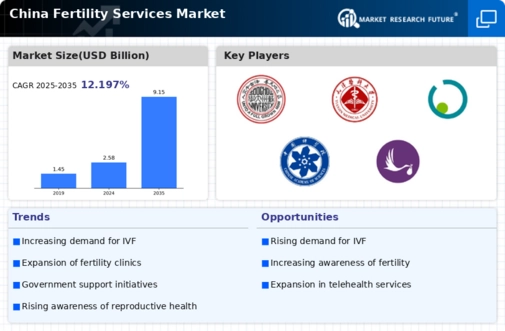The China Fertility Services Market has been witnessing significant growth due to the rising demand for fertility treatments, changing social norms regarding family size, and increasing awareness of reproductive health issues. The competitive landscape in this market is characterized by the presence of various healthcare institutions and clinics that offer a wide range of fertility services, including in-vitro fertilization, egg freezing, and donor programs. As more individuals and couples seek assistance in achieving their reproductive goals, the competition among service providers intensifies.
Factors such as technological advancements in fertility treatments, the quality of service offered, the success rates of various procedures, and the affordability of treatments play crucial roles in shaping competitive dynamics. Additionally, regulatory frameworks and government policies supporting assisted reproductive technologies also influence the market, allowing various players to expand their offerings and enhance their market positions.The Reproductive Health Institute of Shanghai stands out in the China Fertility Services Market due to its established reputation and comprehensive approach to reproductive health.
The institute offers a variety of services, including assisted reproductive techniques, preimplantation genetic diagnosis, and fertility preservation options, addressing the diverse needs of patients. With a strong focus on research and development, the Reproductive Health Institute of Shanghai has implemented innovative technologies that enhance treatment success rates, providing patients with confidence in their services. The institute benefits from collaboration with leading global health organizations, which bolsters its credibility and expertise in the field.
Its commitment to personalized patient care sets it apart from competitors, as it actively aims to provide tailored solutions that cater to individual circumstances, thereby solidifying its presence in the market.Peking University Third Hospital is another key player in the China Fertility Services Market, known for its pioneering contributions to reproductive medicine and infertility treatment. The hospital offers a comprehensive portfolio of fertility services, including IVF, artificial insemination, and hormone therapy, attracting patients from across the region.
Peking University Third Hospital has made significant strides in research and technological advancements, resulting in improved patient outcomes and higher success rates in fertility treatments. The institution has also engaged in strategic partnerships and collaborations to enhance its service offerings and expand its research initiatives. Further, through mergers and acquisitions, Peking University Third Hospital has been able to broaden its geographic reach and clinical capabilities, reinforcing its market position in China.
The hospital’s strong emphasis on education and training ensures that its medical staff remains at the forefront of developments in reproductive healthcare, contributing to its reputation as a trusted provider in the fertility services landscape.















